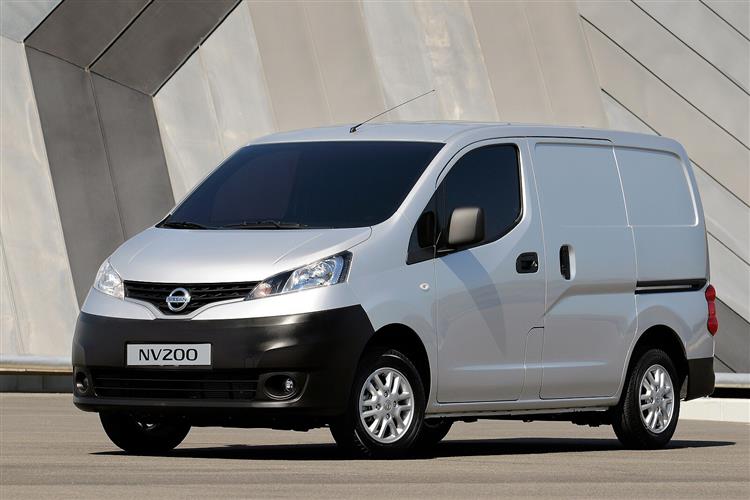V PRACTICAL (some text hidden) --NONE--
By Jonathan Crouch
Introductionword count: 44
Nissan's NV200 is the largest small van you can buy from the 2009-2019 period. Its 4.2 cubic litre loading capacity is matched with value pricing to make it an option from this period that businesses really shouldn't ignore in this sector of the market.
Modelsword count: 6
4dr small van (1.5 dCi diesel/EV)
Historyword count: 206
Back in 2019, Nissan approached the compact sector of the van market with fresh ideas and a clean sheet approach. After years of simply re-badging Renault LCV products, the Japanese brand decided to launch alone with a brand new range of commercials that began with this one - the NV200. It competed in the Citroen Berlingo and Ford Transit Connect-dominated compact van sector where the prices in the 2009-2019 period were often anything but compact for the long wheelbase high capacity versions that many businesses need. The NV200 took a different approach. For less than the kind of money that would buy you many conventional small vans, here you could have one that was 50% bigger. It's a simple sales proposition that many business customers liked, particularly as it included up-to-the-minute design and low running costs courtesy of frugal diesel power. In 2014, a full-electric version, the e-NV200, joined the range - and that EV variant continued on until 2022. Both models could be had either as a panel van or a combi, the latter with the choice of either five or seven seats. The diesel-powered NV200s lasted only until 2019, at which point it was replaced by the NV250 model, basically a re-badged Renault Kangoo.
What You Getword count: 627
Nissan's designers were very clear about their objectives with this vehicle. From the B-pillars forward, it's a car: after that, it's a van. As is common in the compact LCV sector, its underpinnings are based on those of a supermini - in this case, a MK3 Nissan Micra. So far, so predictable. But what makes this NV200 different is the way that it combines the footprint of a short-wheelbase van with the carrying capacity of a much pricier long-wheelbase one. So how exactly did Nissan manage this Tardis-like result? Well the reasons are so simple that you wonder why other makers didn't copy them. First, the cab is designed so that the seats are set as far forwards as they can go. Second, the 55-litre fuel tank is unusually sited under the seats. And thirdly, the leaf-sprung rear suspension is very compact. At the wheel, you sit up high on a supportive seat with excellent views of the road ahead, the gearstick well positioned for easy access from a steering wheel that adjusts for rake but not for reach. The instrumentation is clear but minimalist, with a multi-function digital trip computer to the right of the speedo that can be set to display engine revs, fuel consumption and other journey data. Storage areas - 13 apparently - are everywhere, most notably with a deep box between the seats but as well as the usual glovebox and slim door pockets, the tally also includes cup and bottle holders, coin trays and a large bin beneath the driver's seat. Practicality is the NV200's No.1 selling point. Despite compact dimensions that see it only 1,695mm wide and 4,400mm long, no other compact van from this period can match its 4.2 cubic metre carrying capacity and most need pricey long wheelbase design to get within half a cubic litre of it. That's important, for it means that when you open the a 60:40 asymmetrically-split rear doors, the wider one on the nearside, you'll find a cargo bay boasting a loading area of a size that before 2009 had been previously unheard of in a small van. There's 1358mm of loading height, 1220mm of width between the wheel boxes and 2040mm of load length - though that last figure can be extended to 2,800mm if you go for a model whose original owner specified the optional Versatility Pack, which included a folding passenger seat and an opening mesh bulkhead. Even the standard version however, can accommodate two standard Euro pallets, with six sturdy load-tie rings on the floor to stop them moving about. In other words, for many businesses, there'll be no need to buy a larger Transit Custom-sized van with the higher running costs that would entail. If that's the case, you might have to watch your weights a little - the 752kg payload isn't class-leading - but again, you can't match it for the kind of money Nissan was asking for this vehicle. The gross vehicle weight is 2,000kgs. Talking of weight, if you're trying to hump heavy boxes in, you'll be pleased to find that the compact rear suspension design means that there's a surprisingly low rear loading height figure of 524mm. As is usual with a van of this sort, the designers have made provision for a pair of sliding side doors and the driver is protected by a ladder frame behind the seat, though higher spec variants get a solid steel bulkhead that also does wonders for refinement. As for running costs, well the Euro4-compliant diesel manages competitive CO2 emissions of 137g/km while combined fuel consumption is measured at 54.3mpg, with a gearshift indicator to help operators emulate that figure. Those are NEDC figures. Trips to the dealer are every 12,500 miles - or once a year.
To see the full road test text contact us on 0330 0020 227
Pictures (high res disabled)

.jpg)
|
.jpg)
|
.jpg)
| |||
.jpg)
|
.jpg)
|
.jpg)
|
Scoring (subset of scores)
Category: Vans
| Performance | |
| Handling | |
| Comfort | |
| Space | |
| Styling, Build, Value, Equipment, Depreciation, Handling, Insurance and Total scores are available with our full data feed. | |



